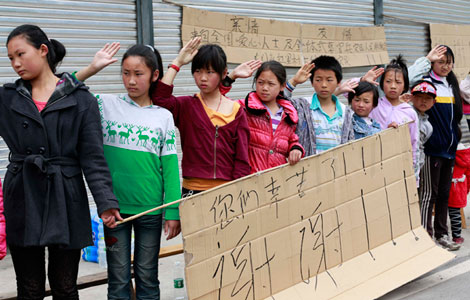Despite optimism, still a long road ahead
Updated: 2012-02-09 10:54
By Huang Xiangyang (China Daily)
|
||||||||
Today China is the news.
The country's rise as an economic power has been one of the hottest topics in the world. Catching the trend The Economist published a special section on China in its Jan 28 issue, the first time in six decades that it has devoted a separate section to a single country. The last time it did so was in 1942 when it covered the United States. "China's emergence as a global power justified giving it a section of its own," says the magazine's Editor-in-Chief John Micklethwait.
I have often heard odes to China's progress in recent years.
An Oxford postgraduate once told me that during her one year of study at the university, rarely had her classes been concluded without the professor mentioning China. A Siemens executive told me matter-of-factly that he needed a new map of Beijing every several months to avoid getting lost in the city's fast-changing landscape. During my visit to the International Herald Tribune's Paris office in December, its publisher, Stephen Dunbar-Johnson, recalled his recent visit to Shanghai and how impressed he was by the construction boom in the town - "I could smell cement in the air."
Such words sound pleasant to Chinese citizens, who have been desperate for the restoration of the country's glory, lost only in modern history. But it would be naive to get carried away with the idea that China will reign supreme in the 21st century, as some people believe.
For decades, the West has viewed China's rise with mixed feelings of curiosity, doubt, disbelief and awe. Pessimists have long forecast an abrupt end to the country's ascendancy, drawing on what they see as evidence ranging from ideological impediment to public discontent, in addition to economic woes in the State and private sectors. Such views were epitomized in The Coming Collapse of China by Gordon Chang published more than 10 years ago, which predicted the country had only several years to go before its collapse.
Nothing could be farther from the truth.
A decade has passed, and China, instead of collapsing, is booming. As the country emerges as the world's second largest economy and largest exporter, more optimistic views have started to dominate.
Yet China is too large, too ancient and too complex a country to make any arbitrary judgment on it. It is a paradox of affluence and scarcity, a combination of modernity and backwardness, a commonwealth of first and third worlds.
While the country held the world's most extravagant Olympic opening ceremony, has sent men into space, and has the fastest high-speed trains, it still struggles to provide enough food and clothing for 30 million people who live in abject poverty, and to provide adequate social security aid for 60 million disabled people.
It guzzles more than 40 percent of the world's total production of coal, one-third of the total steel production and nearly half of the cement, yet it lags far behind in efficient use of energy, which means it has to consume two times more resources than the developed world, and eight times more than Japan, to turn out the same amount of industrial output, casting a shadow on the sustainability of its development.
Everything seems to be made in China, yet the country has profited little from its position in the global supply chain, to the detriment of its labor force and environment.
This is best illustrated by a recent report in The New York Times, which attempted to capture how value moves in global networks by using Apple's iPad and iPhone as examples. It points out that while these products are made in China, the country makes very little money from these popular products and the primary benefits go to the United States. "Only about $10 or less in direct labor wages is paid to Chinese workers" - often subjected to poor treatment - for each unit sold in the US at a price of around $600. "China's role in the world supply chain", the report concludes, "is much smaller than the casual observer would think".
Nothing has really changed in this respect. More than 10 years ago the Los Angeles Times carried a story about the Barbie doll, which pointed out that China gained only 35 cents in service fees for a doll with an export price of $2 and which was sold at retail price of $9.99 in the US market.
For China to become a real superpower, there is still a long way to go.
The author is a senior writer with China Daily.

 Relief reaches isolated village
Relief reaches isolated village
 Rainfall poses new threats to quake-hit region
Rainfall poses new threats to quake-hit region
 Funerals begin for Boston bombing victims
Funerals begin for Boston bombing victims
 Quake takeaway from China's Air Force
Quake takeaway from China's Air Force
 Obama celebrates young inventors at science fair
Obama celebrates young inventors at science fair
 Earth Day marked around the world
Earth Day marked around the world
 Volunteer team helping students find sense of normalcy
Volunteer team helping students find sense of normalcy
 Ethnic groups quick to join rescue efforts
Ethnic groups quick to join rescue efforts
Most Viewed
Editor's Picks

|

|

|

|

|

|
Today's Top News
Health new priority for quake zone
Xi meets US top military officer
Japan's boats driven out of Diaoyu
China mulls online shopping legislation
Bird flu death toll rises to 22
Putin appoints new ambassador to China
Japanese ships blocked from Diaoyu Islands
Inspired by Guan, more Chinese pick up golf
US Weekly

|

|







